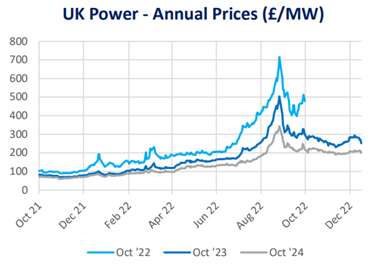
Affordable wins – green tech solutions to save your business energy this winter
Read time: 3 minutes
As the energy price cap for businesses is set at 21.1p/kWh for electricity until April 2023, we’re all acutely aware that the cost of running your business is going to increase over the coming months. Whilst it’s important to consider long term solutions to adapt to these costs in the longer term, being smart about how your energy is used could provide some much-needed relief this winter.
Smart meters are one of the easiest ways to keep tabs on your daily energy usage, allowing you to detect period of high usage and waste. By observing how your business is using energy and how much it is spending day-to-day, you can streamline or cut back on energy-intensive activities and receive more accurate bills.
Use your thermostat to ensure your workspace is only being heated and cooled when necessary. Reducing your heating by one degree could cut your energy bill by up to eight per cent, and ensuring your heating, ventilation and air conditioning (HVAC) technology is only active during business hours can also have a significant impact on your usage and bills. Some other key HVAC solutions include:
Ensure heating and air conditioning aren’t active in the same place at the same time
Turn off HVAC when meeting rooms aren’t in use
Consider the spacing of employee desks in relation to radiators and air conditioning
Undergo regular maintenance inspections to ensure HVAC systems are working at maximum efficiency
When considering energy efficiency measures, one opportunity you may not be familiar with is Voltage Management or Voltage Optimisation (VO).
“There’s a difference between the voltage supplied to a building and the voltage appliances are designed to operate at more efficiently,” explains Gary Vizard, managing director at EnergyAce. “On average, the voltage across UK business is 242V, but most electrical equipment is designed to work across the whole European Union and so the optimum operating voltage electrical equipment needs to work most efficiently sits around 220V and 230V. This overvoltage not only costs more, but it also shortens the life of electrical equipment.”
Gary highlights that many businesses aren’t optimising their electrical equipment for most efficient use and business owners are often unaware of the specific voltage requirements their equipment may have.
“The surplus voltage produces additional heat, noise, vibration, and causes stress on electrical equipment leading to system damages. Computers and LED lighting are particularly vulnerable to overvoltage and fail much sooner if not optimised properly,” says Gary.”
Companies like EnergyAce offer VO solutions and support. Their VO system ensures that buildings only consume the energy they need, reducing overvoltage issues and energy waste. The system works by optimising incoming voltage and lowering electricity consumption to reduce bills and electrical equipment failure.
“Installation of these systems usually take around one hour with no need to change your electricity supplier. They can reduce electricity bills by up to 20 per cent, improve the lifespan of electric equipment, require no maintenance and have a fifteen year warranty,” says Gary.
If you’d like to know more about the services EnergyAce offer, visit their profile on our Marketplace.


Laptops use much less energy intensive than desktops, and employees tend to take their laptops home at the end of the day meaning there are no overnight costs from machines left on standby. Research has shown that desktops left on standby through the night can cost businesses up to £50 per year per desk. This includes printers, copiers, and the like. When replacing office equipment, look at ENERGYSTAR-rated hardware which is more energy efficient and better suited to cutting costs.
Choose your lighting carefully. Besides the obvious solutions, such as turning off lights in areas that aren’t in use, making the most of natural sunlight, and ensuring non-essential lighting is off overnight, replacing your bulbs can have a phenomenal impact on your energy use. For some businesses with large spaces in need of light, up to 40% of energy use goes into lighting. Switching incandescent bulbs with CFL, LEDs or halogens will have noticeable benefits when it comes to energy use.
You can find an energy-efficient light installer via our Marketplace to learn more about the process.
Engage your staff. Ensuring everybody within your business is well-informed about energy efficiency and the steps that can be taken to reduce waste and lower costs is essential. Making the effort to be more energy-savvy will not be impactful unless everybody within your organisation is on-board. Consider hosting company-wide focus groups, and make sure that your company’s energy plans are clearly articulated to all staff.